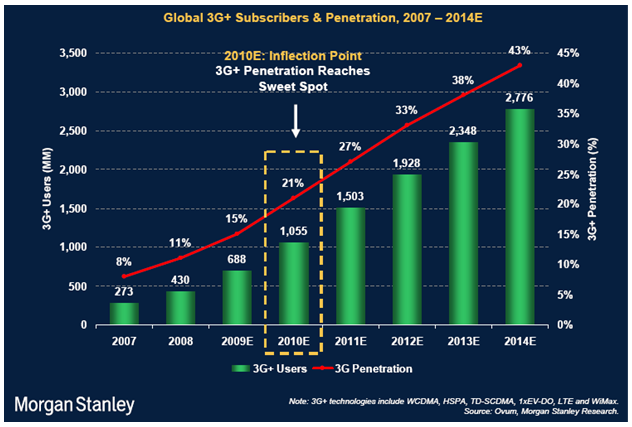infoTECH Feature
November 02, 2009
Smartphones, the Future of Mobility and 'The Back 40'
The Back 40 (noun): wild or rough terrain adjacent to a developed area.
This last week marked an auspicious event for those of us rooted in Silicon Valley. The 40th anniversary of the creation (and yes, I’m not using that world lightly) of the early Internet… a single link between UCLA and SRI. For four decades we’ve been working to tame that Back 40.
And what taming it’s been. Every decade, speeds and applications improve 100-fold. On the mobile front, I can’t say we’re completely there yet. I still see weeds. But we’re getting close.
So what does this mean, after all these years, when we can finally focus on reaping what we’ve sown? When we can finally turn our attention to services and applications, assuming a network infrastructure to support them? And what does it mean for the mobile operators?
With 3G (mostly) in place, you can now turn your attention to growing the subscriber base. As Morgan Stanley reported, this coming year will be the inflection point on a global level… the year that operators turn their attention to offering the types of data services optimized for mobile broadband, thanks to a billion subscribers with advanced devices. What is almost more telling is iPhone (News - Alert) growth, a proxy for the future of advanced applications leveraging the global 3G infrastructure.
(Click image below to enlarge.)

Compare this growth to the geographically-limited i-mode offering, the world’s first 3G data service, offered by DoCoMo in Japan, and the urgency is clear. What urgency? What does this growth imply for your support organization when you are a Tier 1 operator with 20 million or so subscribers running around with the equivalent of PCs in their pockets?
(Click image below to enlarge.)

(Click image below to enlarge.)

Compare this growth to the geographically-limited i-mode offering, the world’s first 3G data service, offered by DoCoMo in Japan, and the urgency is clear. What urgency? What does this growth imply for your support organization when you are a Tier 1 operator with 20 million or so subscribers running around with the equivalent of PCs in their pockets?
(Click image below to enlarge.)

As a contrast, in the wireline space, customers rarely call their providers. When was the last time you called AT&T (News - Alert), Comcast, or your local ISP? Why? Your end device… the PC or laptop… isn’t provided by the operator. You are more likely to call Microsoft (News - Alert), Dell, or HP with OS or hardware issues. The opposite is true with mobility. In most cases, there is an implied link between the phone and the operator, subsidy or no subsidy. Support call volumes are much greater; call types are more complex.
Unfortunately, you are only marginally staffed to even meet today’s requirements. Fast forward a few years with the majority of your subscribers calling with media, browser, and navigation issues, and it can’t be business as usual. You require a new support paradigm. As I’ve written in the past, you’ll need a real-time over-the-air link between your frontline CSR (News - Alert) and the phone itself, capable of reading and sending configuration settings as well as diagnosing software and hardware issues. But what about updating the phone? It isn’t a day you go by without reading of some HTC issue, RIM’s plans to load their 5.0 OS onto existing phones via a desktop application, or Apple’s use of iTunes to push upwards of 5 updates a year to the iPhone.
What you’ll require is a scalable and secure way of pushing large updates OTA to the phone, be it the radio image, the embedded OS, or even applications. Think of Windows or Mac Update, but wireless. You must be able to plan mass updates in advance, targeting groups of subscribers at off-hours. And, the client code running on the phone should select the best network available for the download, including WiFi, while delaying it if necessary due to roaming or lack of 3G connectivity.
The client must also be able to intelligently pick up where it left off if a download was interrupted. Needless to say, any update process must clearly explain to the user what will occur and the reason for the update. Admittedly, some of these capabilities exist with the likes of Android (News - Alert) or even the Palm Pre today, but they must be scaled many-fold, and incorporated within an operator’s OTA solution for frontline care.
Smartphone OTA updates…. one implement for taming that Back 40.
David Ginsburg is vide president of marketing at Innopath Software.
Edited by Michael Dinan
infoTECH Headlines
What Is AWS EFS? Features, Use Cases, and Critical Best Practices
Cost-Effective Approaches to s1000d Conversion
A virtual crossroads for technology enthusiasts
Benefits of employee monitoring software in preventing overworking of workers
CI/CD: Trends and Predictions for 2024
Technical Documentation for IT: A Practical Guide
Managing Your Costs on AWS: A 2024 Guide
What Is Application Dependency Mapping?
Top 5 Kubernetes Errors and How to Solve Them
How Artificial Intelligence Can Improve the World of Online Gaming Platforms
Vonage Elevates Cloud Communications with Advanced Noise Cancellation and AI Integration
Rich Tehrani
Rich Tehrani
What is a Data Lake
Rich Tehrani
Rich Tehrani



 By
By 
